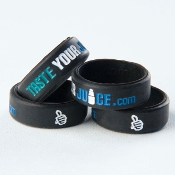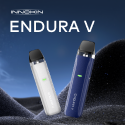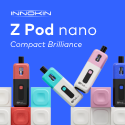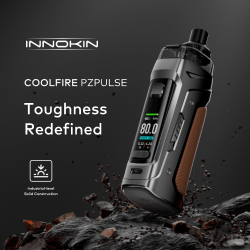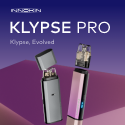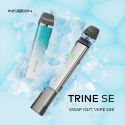Author: John Muchow
Upgrading the temperature measuring gear for battery testing
I “stole” the trustworthy Omegaette HH306A temperature meter from my day job testing station and have been using to measure vaping cell temperature during testing. It’s time to move it back permanently. It’s just too annoying moving it back and forth when needed. The other meters I have can be used but aren’t quite as accurate.
This gave me an opportunity to upgrade though to the Fluke 52 II, an incredible two channel meter. Especially when paired with tight tolerance thermocouples (temperature sensors) and an extra NIST-traceable calibration done before the Fluke was shipped to me. In the photo you can see two different sensors showing the same 26.8°C ambient temperature…just what I want to see.
Photo: https://imgur.com/a/ZiMongF
You can see one of the temperature sensors on the upper right, with its “bead” tip circled in red. It’s this tiny tip that makes these thermocouples so great for measuring cell temperature. It responds very quickly to the changing cell temperature, it thermally couples itself well to the cell using a dot of thermal paste or thermal epoxy, and it’s easy to isolate from the effects of cooler ambient air using Kapton tape to mount it to the bare cell (wrap removed).
Exciting stuff? No, not really.
Just another step to ensure that the results I give you are accurate.
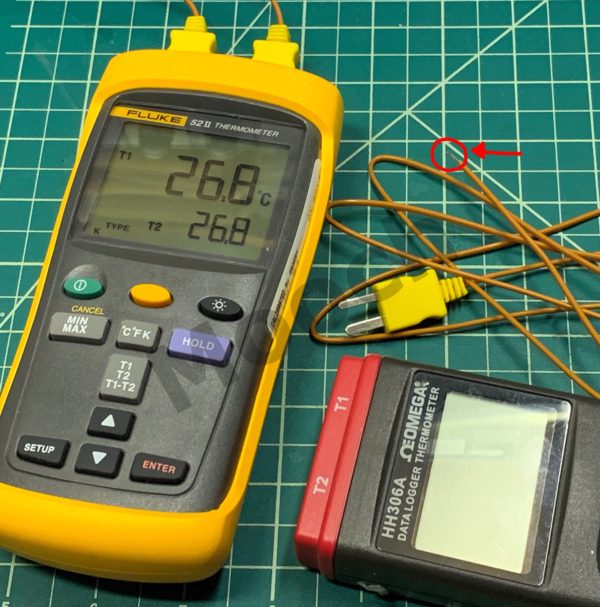
A BATTERY MOOCH POST: Plastic wrap changes for LG batteries
LG Chem is changing the outer plastic wrap for its round batteries. I’ve only seen it on one type of battery so far but it seems that it will be on all of them eventually.
The changes include adding a 2D barcode box, adding warning text, and changing model numbers to match international naming standards.
Here’s are images of LG Chem’s announcement: https://imgur.com/a/QtLVCKB
This DOES NOT mean the LG batteries with the older wraps are “bad”. This DOES NOT mean the performance of any LG batteries has changed. There WILL eventually be fakes using this new wrap format. Do not assume any LG battery with the new wraps has to be genuine.
That’s everything I know as of now.
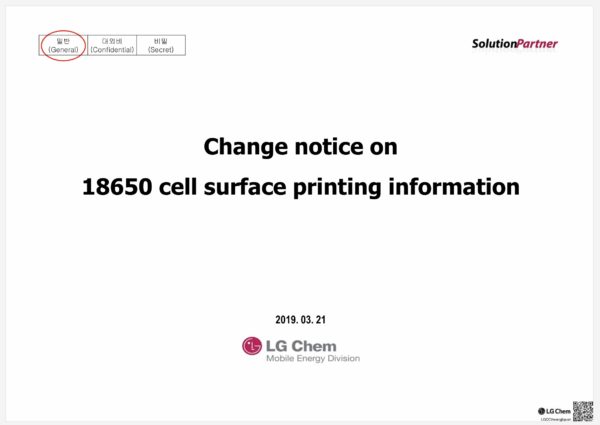
A BATTERY MOOCH POST: Fake Murata 21700 VTC6A alert
Post #9 of 9 about battery fakes. Please read post #1 (link below) before asking any questions here. Thanks!
http://www.tasteyourjuice.com/wordpress/archives/19048
The fakes have a much larger top contact and do not have the bottom vent ring and QR code box that genuine Murata 21700 VTC6A’s have. The fakes have a couple of characters stamped on the bottom. This is typical for Samsung, not Murata. The fakes have a narrower ring around the cell near the top but this will be hard to notice without a genuine Murata 21700 VTC6A for comparison.
Photos of the fakes and test results: https://imgur.com/a/OYt2PWW
The fakes performed terribly compared to genuine Murata 21700 VTC6A’s. The physical differences and the crappy performance versus genuine VTC6A’s means they are fakes. DO NOT USE THESE FAKES FOR ANYTHING!
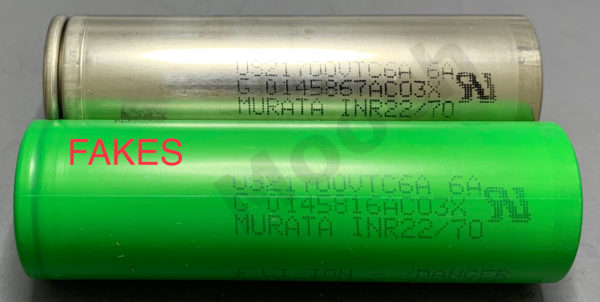
A BATTERY MOOCH POST: Fake Sony VTC5A Alert
Post #8 of 9 about battery fakes.
Please read post #1 (link below) before asking any questions here. Thanks!
http://www.tasteyourjuice.com/wordpress/archives/19048
These cells have a different metal can and venting disk from known genuine Sony VTC5A’s but they do have the two “dimples” on top common to all VTC 18650’s and tested as 2528mAh. To date I have never seen a non-VTC cell with these dimples so they might be VTC’s (not VTC5A’s though) or the counterfeitors have gotten better.
The fakes also have two micro-weld lines under the white top sealing gasket (not the top insulating disk for the wrap) which genuine VTC5A’s do not have. The fakes have a single ring around the battery near the top whereas genuine VTC5A’s have two rings at the top and one flat ring at the bottom. The fakes have a smooth central portion for the venting disk and genuine VTC5A’s have a small “button” structure there.
Photos of the fakes and test results: https://imgur.com/a/R9ipZnf
The physical differences and the crappy performance versus genuine Sony VTC5A’s means they are fakes. DO NOT USE THESE FAKES FOR ANYTHING!
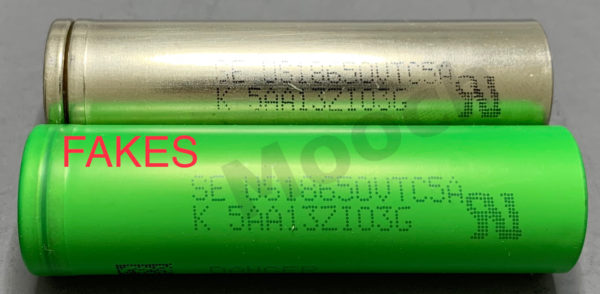
A BATTERY MOOCH POST: FAKE Murata VTC5 Alert (repost)
Post #7 of 9 about battery fakes.
This is a repost due to an error I made. ktvapes2632 on Instagram noticed I used a photo of fake VTC5A’s instead of fake VTC5’s. Luckily the same cell is used for both fakes so nothing else changes but here is the corrected post. My apologies for any confusion this has caused
Please read post #1 (link below) before asking any questions here. Thanks!
http://www.tasteyourjuice.com/wordpress/archives/19048
These cells look different from known genuine Sony VTC5’s but they do have the two “dimples” on top common to all VTC 18650’s and tested as 2455mAh. I have never seen a non-VTC cell with these dimples so the fakes could still be VTC’s. The fakes have two micro-weld lines under the white top sealing gasket (not the top insulating disk for the wrap) which genuine VTC5’s do not have. The fakes do not have the four radial lines on the venting disk that genuine VTC5’s have. The fakes have a single ring around the battery near the top whereas genuine VTC5’s have two rings.
Photos of the fakes and test results: https://imgur.com/a/062HF5H
CHECK FOR THE RADIAL LINES VERY SLOWLY AND CAREFULLY WITH BRIGHT BACKLIGHTING AND A MAGNIFIER OR READING GLASSES. ROTATE THE BATTERY AT LEAST A COUPLE OF TIMES, CHANGING ANGLES. THEY ARE HARD TO SEE. PLEASE DO NOT ACCUSE A VENDOR OF SELLING FAKES UNTIL YOU HAVE CHECKED EVERYTHING I HAVE DESCRIBED ABOVE VERY CAREFULLY. PEOPLE ARE NOT SEEING THE RADIAL LINES THE FIRST TIME THEY CHECK AND ARE SAYING A VENDOR SOLD FAKES ONLY TO FIND OUT LATER THEY MISSED SEEING THE LINES.
This date/batch code might be used on genuine cells! Do not assume all VTC5’s with this code are fake. The physical differences and the crappy performance versus genuine VTC5’s means they are fakes. DO NOT USE THESE FAKES FOR ANYTHING!
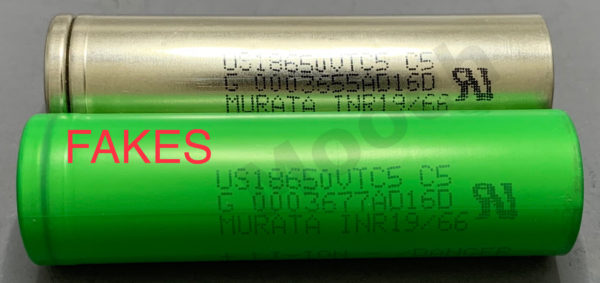
A BATTERY MOOCH POST: FAKE Samsung 30T alert
Post #6 of 9 about battery fakes.
Please read post #1 (link below) before asking any questions here. Thanks!
http://www.tasteyourjuice.com/wordpress/archives/19048
The fake 30T’s are using a valid code, a zero, as the second character of the first line of codes on the metal can. They are also using free-floating (unglued) top insulating rings like genuine 30T’s. But the fakes do not have the the four radial score lines in the venting disk like genuine 30T’s and the metal can codes are positioned lower than on genuine 30T’s.
There are also genuine 30T’s with “N30T” as the top line of codes on the metal can. I do not know if there are fakes using this code or not. Check for the radial venting disk lines. No lines = fake.
Photos of the fakes and test results: https://imgur.com/a/sAdsUzq
The fakes perform much worse than genuine 30T’s and have very low current ratings. DO NOT USE THE FAKES FOR ANYTHING.
A BATTERY MOOCH POST: Fake LG HG2 alert
Post #5 of 9 about battery fakes. Please read post #1 (link below) before asking any questions here. Thanks!
http://www.tasteyourjuice.com/wordpress/archives/19048
These fakes are very hard to detect visually. Both fake and genuine HG2’s have four spot weld points on top and free-floating (not glued on) top ring insulators. The fakes have a slightly wider ring around the battery near the top but that will be very hard to see without having a genuine HG2 for comparison.
Photos of the fakes and test results: https://imgur.com/a/ZKY80ng
There’s no other way to detect the fakes than internal resistance (IR) or discharge testing. The HG2 has an AC IR spec of <=20mOhms. My genuine ones measure around 15mOhms. The fakes measure about 35mOhms, indicating that they will have huge voltage sag and a low current rating.
The fakes perform MUCH worse than genuine HG2’s, DO NOT USE THESE FAKES!
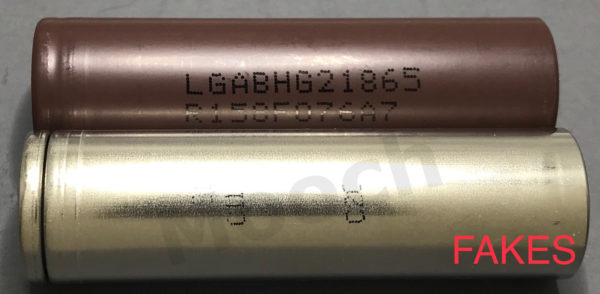
A BATTERY MOOCH POST: Fake Samsung 25R Alert
Post #4 of 9 about battery fakes.
Please read post #1 (link below) before asking any questions here. Thanks!
http://www.tasteyourjuice.com/wordpress/archives/19048
These fakes have two micro-weld lines on top, underneath the top insulating ring. Genuine 25R’s do not have these micro-weld lines. In bright light, look at the metal can through the wrap, near the top. Genuine 25R’s must have a five as the second character in the first line of codes on the metal can. The other characters and codes do not matter. If it is not a five then it’s a fake. If there are no codes then it’s a fake. If the second character is a five then it can be genuine or a fake (codes can be faked!). The fakes have the same free-floating (loose) top insulating ring as genuine 25R’s. Do not assume that if the ring is loose (not glued) that the battery is genuine!
Photos of the fakes and test results: https://imgur.com/a/GYkjyVa
The fakes have a very low current rating and should never be used for anything! We do not know their age or internal condition. I will not be testing the fakes because they can change at any time and they might have used several different batteries for the fakes.
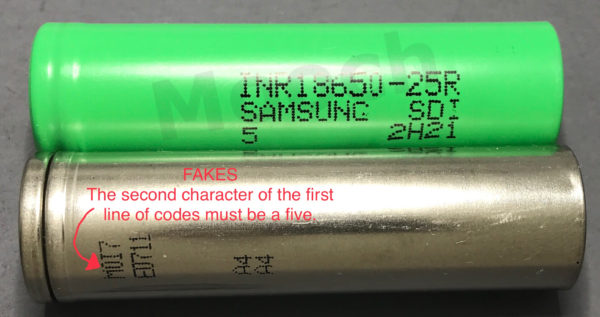
A BATTERY MOOCH POST: Fake LG HE4 Alert
Post #3 of 9 about battery fakes.
Please read post #1 (link below) before asking any questions here. Thanks!
http://www.tasteyourjuice.com/wordpress/archives/19048
The fakes do not have the four top spot weld points that the HE4 has. The fakes also have a flatter ring around the cell near the top and a darker plastic top crimp seal (not the top flat ring insulator you can remove) than the genuine HE4.
Photos of the fakes and test results: https://imgur.com/a/7RkdDj5
The performance of the fakes is terrible compared to genuine HE4, which is no surprise. I do not know what cell they rewrapped for these fakes or what its current rating is. If you have any of these fakes, don’t use them in anything!
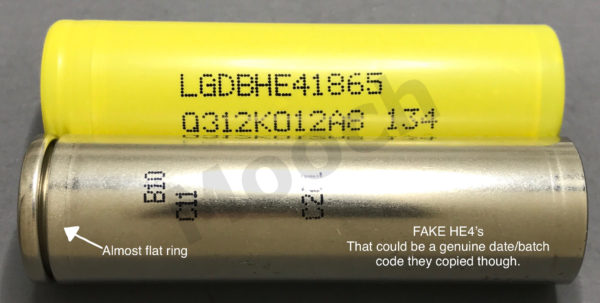
A BATTERY MOOCH POST: Fake Samsung 30Q alert
Post #2 of 9 about battery fakes. Please read post #1 (click HERE) before reading this post. Thanks!
The code on the can makes me think they might be 2.75A-rated Samsung 29E’s. This fake looks a LOT like the 30Q and would test out about the same in capacity if a testing charger was used to check it. The top insulating ring was free-floating (not glued on) too.
Photos of the fakes and test results
The counterfeiters are definitely learning! But more we expose them the harder and more expensive their job gets and that is always a good thing.
Right now the top code line printed on the metal can is the best way to spot the fake as it can be seen through the wrap in bright light. I‘m sure the codes will soon be faked too though.
The performance of these cells is miserable compared to the genuine 30Q and the cell will run a lot hotter. If you have any of these fakes, don’t use them in anything!
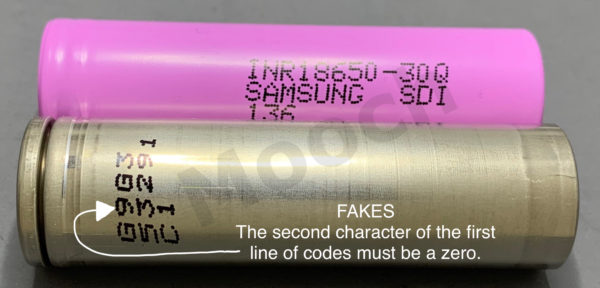















 Store
Store
